Browse lipids - Glycerophospholipids (GP)
| Lipid Name | Description | |
|---|---|---|
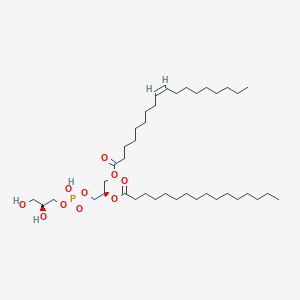
|
PG(18:1(9Z)/16:0) |
PG(18:1(9Z)/16:0) is a lipid of Glycerophospholipids (GP) class. Pg(18:1(9z)/16:0) is associated with abnormalities such as Infection. The involved functions are known as Signal Transduction, cell activation, Anabolism, biotin binding and Binding (Molecular Function). Pg(18:1(9z)/16:0) often locates in Skin. The associated genes with PG(18:1(9Z)/16:0) are CD1D gene. The related lipids are Fatty Acids, Cardiolipins and Diphosphatidylglycerols. |
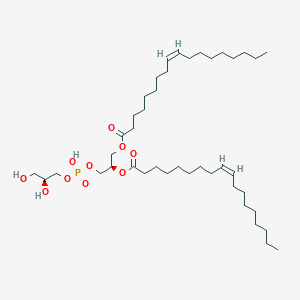
|
PG(18:1(9Z)/18:1(9Z)) |
PG(18:1(9Z)/18:1(9Z)) is a lipid of Glycerophospholipids (GP) class. Pg(18:1(9z)/18:1(9z)) is associated with abnormalities such as Neonatal hemochromatosis, Renal tubular disorder, Hereditary pancreatitis and UDPglucose 4-epimerase deficiency disease. The involved functions are known as Genetic Translation Process, Regulation, Saturated, enzyme activity and Cytokinesis. Pg(18:1(9z)/18:1(9z)) often locates in Membrane, soluble, Tissue membrane, membrane fraction and Thylakoid Membrane. The associated genes with PG(18:1(9Z)/18:1(9Z)) are COIL gene, P4HTM gene, GRAP2 gene, Integral Membrane Proteins and synthetic peptide. The related lipids are Liposomes, Fatty Acids, Sphingolipids, DOPE and 1,2-oleoylphosphatidylcholine. |
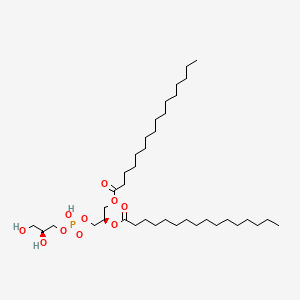
|
PG(16:0/16:0) |
PG(16:0/16:0) is a lipid of Glycerophospholipids (GP) class. |
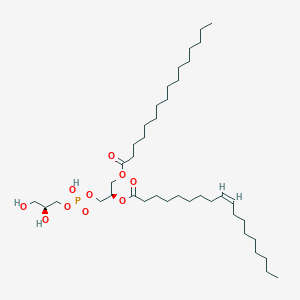
|
PG(16:0/18:1(9Z)) |
PG(16:0/18:1(9Z)) is a lipid of Glycerophospholipids (GP) class. |
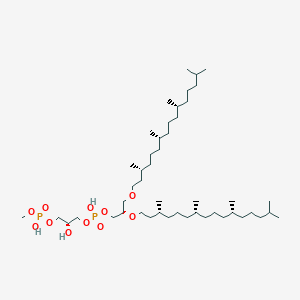
|
PGP-Me |
PGP-Me is a lipid of Glycerophospholipids (GP) class. Pgp-me is associated with abnormalities such as STARGARDT DISEASE 1 (disorder). The involved functions are known as Signal and Subtraction process. The associated genes with PGP-Me are TDG gene. The related lipids are Cardiolipins. |

|
PI(16:0/16:0) |
PI(16:0/16:0) is a lipid of Glycerophospholipids (GP) class. |
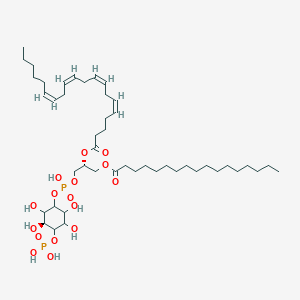
|
phosphatidylinositol-4-phosphate |
phosphatidylinositol-4-phosphate is a lipid of Glycerophospholipids (GP) class. Phosphatidylinositol-4-phosphate is associated with abnormalities such as Renal tubular disorder, Oculocerebrorenal Syndrome, Lowe, Infection and Rhinovirus infection. The involved functions are known as Agent, Signal Transduction, Synthesis, Regulation and Process. Phosphatidylinositol-4-phosphate often locates in Membrane, Tissue membrane, Endosomes, Cytoskeleton and Cell membrane. The associated genes with phosphatidylinositol-4-phosphate are Homologous Gene, Homologous Protein, CDC42 gene, Genome and PIK4CB gene. The related lipids are phosphatidylinositol 4-phosphate, phosphatidylinositol 5-phosphate, Phosphatidylserines, phosphatidylinositol 3-phosphate and Total cholesterol. |
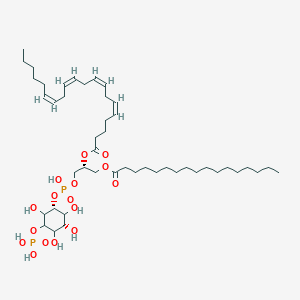
|
PIP[5'](17:0/20:4(5Z,8Z,11Z,14Z)) |
PIP[5'](17:0/20:4(5Z,8Z,11Z,14Z)) is a lipid of Glycerophospholipids (GP) class. Pip[5'](17:0/20:4(5z,8z,11z,14z)) is associated with abnormalities such as Diabetes Mellitus, Non-Insulin-Dependent. The involved functions are known as Phosphorylation, 1-phosphatidylinositol-4-phosphate 5-kinase activity, Signal, cellular process and Signal Transduction. Pip[5'](17:0/20:4(5z,8z,11z,14z)) often locates in Membrane, Cytoskeleton, Extracellular, Protoplasm and Plasma membrane. The associated genes with PIP[5'](17:0/20:4(5Z,8Z,11Z,14Z)) are PIKFYVE gene, Homologous Gene, PTEN gene, Genome and LGALS4 gene. The related lipids are phosphatidylinositol 5-phosphate, phosphatidylinositol 4-phosphate, Liposomes and Sphingolipids. |
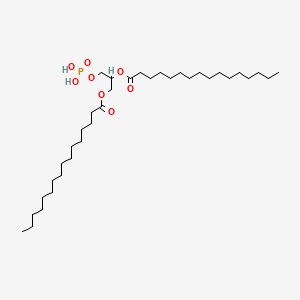
|
19698-29-4 |
19698-29-4 is a lipid of Glycerophospholipids (GP) class. The involved functions are known as lipoate synthase activity and lipoyl(octanoyl) transferase activity. The related lipids are Phosphatidic Acid. |
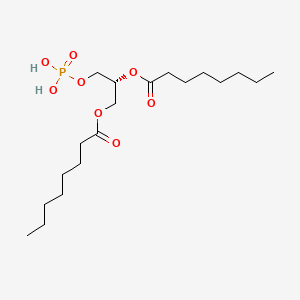
|
Dioctanoylphosphatidic acid |
Dioctanoylphosphatidic acid is a lipid of Glycerophospholipids (GP) class. The involved functions are known as vesicle-mediated transport, Anabolism, Binding (Molecular Function), Regulation and Stimulus. Dioctanoylphosphatidic acid often locates in Endoplasmic Reticulum, Secretory Vesicles, trans-Golgi Network, Organelles and Membrane. The associated genes with Dioctanoylphosphatidic acid are NCF1 gene, FPR1 gene, neutrophil cytosol factor 67K, neutrophil cytosol factor 40K and THOC4 gene. The related lipids are lysophosphatidic acid, Phosphatidic Acid, dioctanoylphosphatidic acid, phosphatidylpropanol and Phosphatidic Acids. |
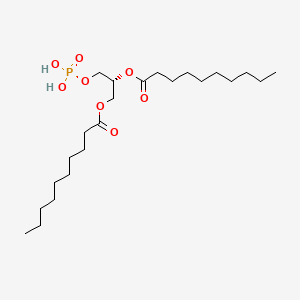
|
1,2-Didecanoyl-3-phosphatidic acid |
1,2-Didecanoyl-3-phosphatidic acid is a lipid of Glycerophospholipids (GP) class. |

|
Dimyristoyl phosphatidic acid |
Dimyristoyl phosphatidic acid is a lipid of Glycerophospholipids (GP) class. |

|
dipalmitoylphosphatidic acid |
dipalmitoylphosphatidic acid is a lipid of Glycerophospholipids (GP) class. Dipalmitoylphosphatidic acid is associated with abnormalities such as Exanthema, protrusion and Lung Diseases, Interstitial. The involved functions are known as Pressure- physical agent, Process, Shock, Baresthesia and Chemical Surfactants. Dipalmitoylphosphatidic acid often locates in Cell membrane, Membrane, Lipid Bilayers, Tissue membrane and Protoplasm. The associated genes with dipalmitoylphosphatidic acid are HOXA10 gene and FASTK Gene. The related lipids are Phosphatidylserines, 1,2-distearoylphosphatidylethanolamine, Phosphatidic Acid, stearic acid and Fatty Acids, Nonesterified. |
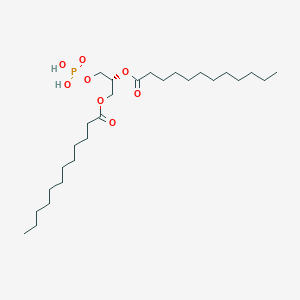
|
Dilauroyl phosphatidic acid |
Dilauroyl phosphatidic acid is a lipid of Glycerophospholipids (GP) class. |
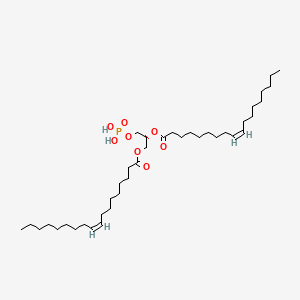
|
PA(18:1(9Z)/18:1(9Z)) |
PA(18:1(9Z)/18:1(9Z)) is a lipid of Glycerophospholipids (GP) class. The involved functions are known as adenylate cyclase activity, inhibitors, Drug Interactions, Membrane Fluidity and Force. Pa(18:1(9z)/18:1(9z)) often locates in Cell membrane, Tissue membrane, Epidermis, Connective Tissue and Back. The associated genes with PA(18:1(9Z)/18:1(9Z)) are growth promoting activity and RAF1 gene. The related lipids are Phosphatidic Acid, Lysophospholipids, lysophosphatidic acid, Lysophosphatidylcholines and dioleoyl phosphate. |